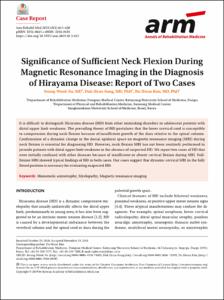KUMEL Repository
1. Journal Papers (연구논문)
1. School of Medicine (의과대학)
Dept. of Rehabilitation Medicine (재활의학)
Significance of Sufficient Neck Flexion During Magnetic Resonance Imaging in the Diagnosis of Hirayama Disease: Report of Two Cases
- Affiliated Author(s)
- 김두환
- Alternative Author(s)
- Kim, Du Hwan
- Journal Title
- Annals of rehabilitation medicine
- ISSN
- 2234-0653
- Issued Date
- 2019
- Abstract
- It is difficult to distinguish Hirayama disease (HD) from other mimicking disorders in adolescent patients with distal upper limb weakness. The prevailing theory of HD postulates that the lower cervical cord is susceptible to compression during neck flexion because of insufficient growth of the dura relative to the spinal column. Confirmation of a dynamic change in the dorsal epidural space on magnetic resonance imaging (MRI) during neck flexion is essential for diagnosing HD. However, neck flexion MRI has not been routinely performed in juvenile patients with distal upper limb weakness in the absence of suspected HD. We report two cases of HD that were initially confused with other diseases because of insufficient or absent cervical flexion during MRI. Full-flexion MRI showed typical findings of HD in both cases. Our cases suggest that dynamic cervical MRI in the fully flexed position is necessary for evaluating suspected HD.
- Department
- Dept. of Rehabilitation Medicine (재활의학)
- Publisher
- School of Medicine (의과대학)
- Citation
- Seung-Wook No et al. (2019). Significance of Sufficient Neck Flexion During Magnetic Resonance Imaging in the Diagnosis of Hirayama Disease: Report of Two Cases. Annals of rehabilitation medicine, 43(5), 615–620. doi: 10.5535/arm.2019.43.5.615
- Type
- Article
- ISSN
- 2234-0653
- Appears in Collections:
- 1. School of Medicine (의과대학) > Dept. of Rehabilitation Medicine (재활의학)
- 파일 목록
-
-
Download
 oak-2019-0286.pdf
기타 데이터 / 932.06 kB / Adobe PDF
oak-2019-0286.pdf
기타 데이터 / 932.06 kB / Adobe PDF
-
Items in Repository are protected by copyright, with all rights reserved, unless otherwise indicated.